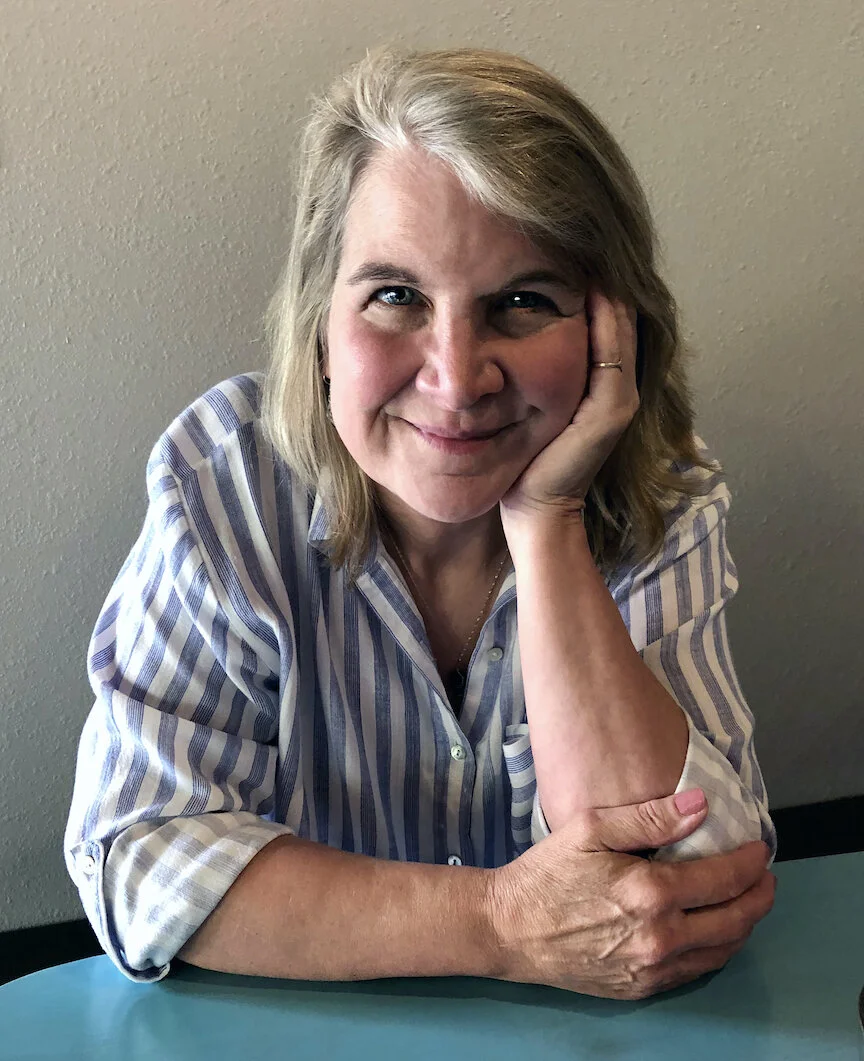Interview with artist Evan Lindquist
Evan Lindquist is an Arkansas treasure. His mastery of traditional techniques to engrave onto copper plates has earned him international recognition as a master engraver. Originally from Kansas, Evan and his wife Sharon moved to Jonesboro, Arkansas in 1963 where he taught at Arkansas State University for 40 years. His prints are in many public and private collections in the United States and other countries. Evan has also earned many awards and honors. A few of the most notable are the Arkansas Governor’s Lifetime Achievement Award in 2004, the Lifetime Achievement Award from The Society of American Graphic Artists and being named the first Artist Laureate for The State of Arkansas in 2013. You can learn even more about Evan at Wikipedia, the Encyclopedia of Arkansas, YouTube, and at evanlindquist.com. His prints are available at Sara Howell Studio and Gallery in Jonesboro and at M2 Gallery in Little Rock.
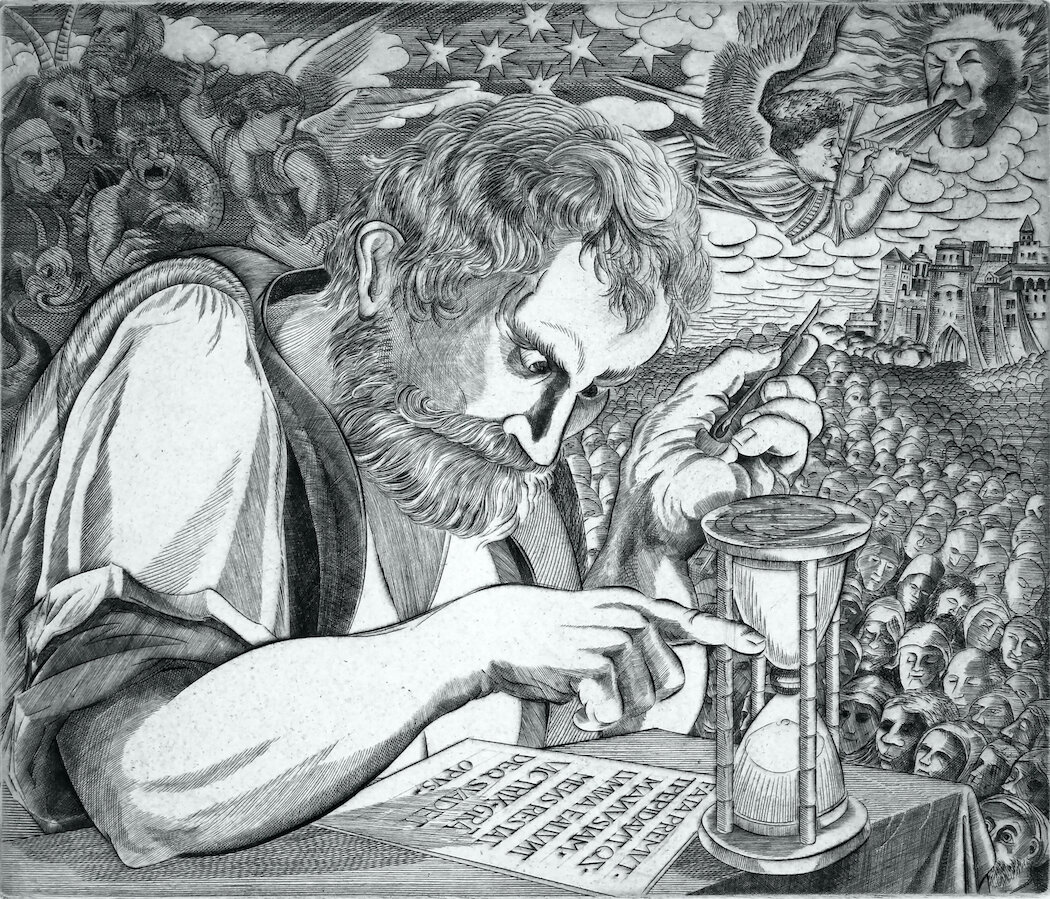
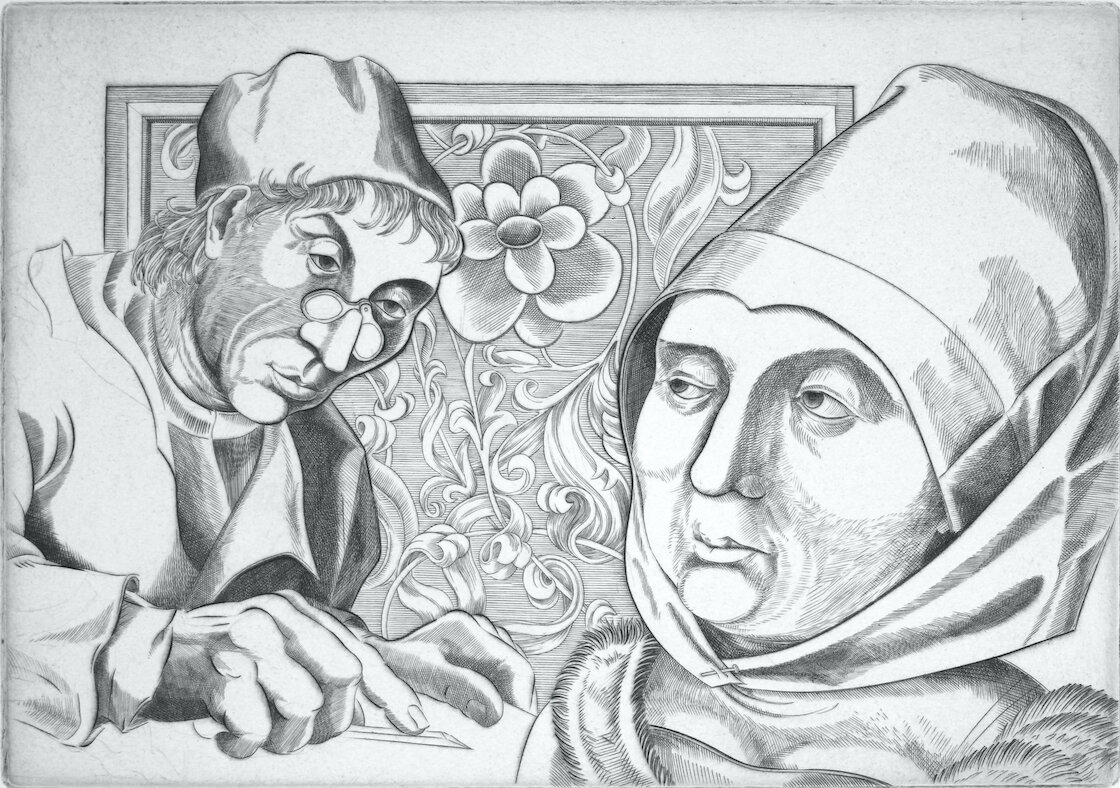
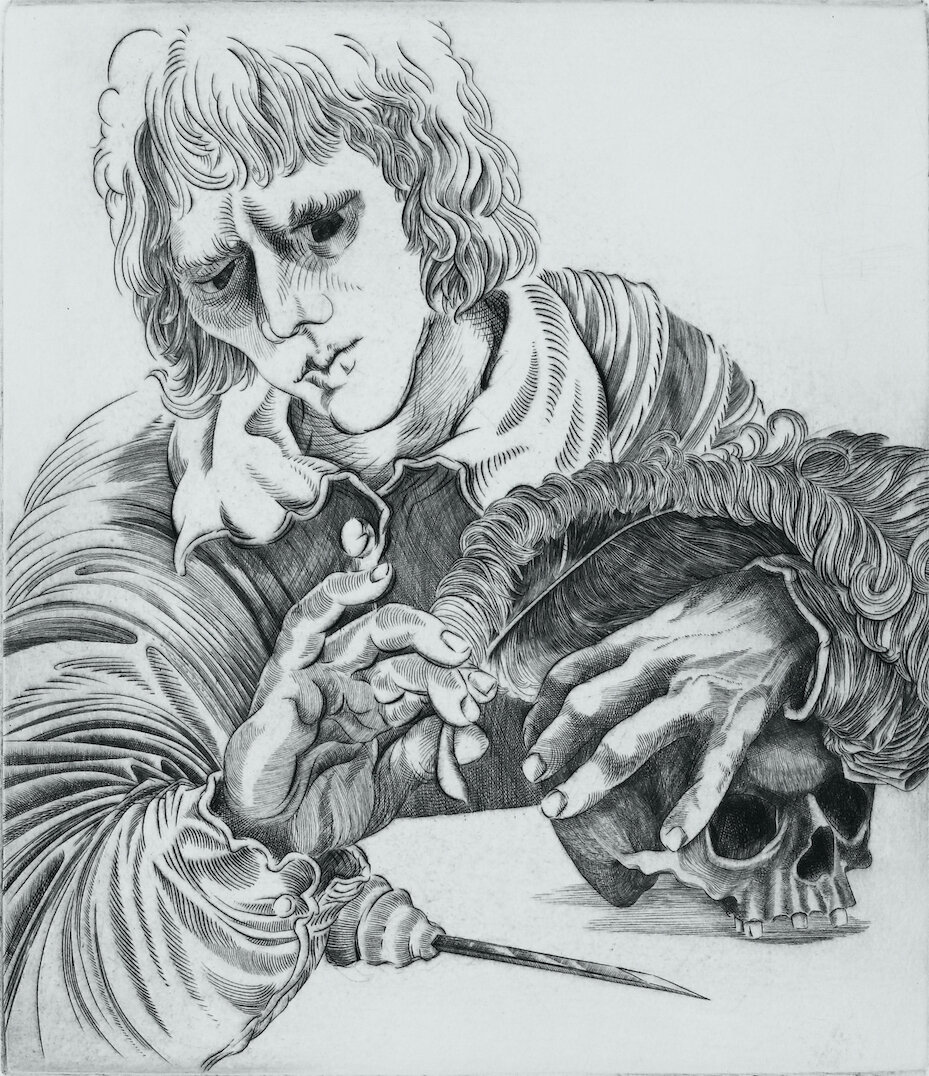
“Let’s face it — Being safe is just BORING!”
AAS: Would you talk about your background? I understand you were born in Salina, Kansas and attended the University of Iowa.
EL: Yes, I was born in Asbury Hospital in Salina, Kansas, during The Great Depression. It was 1936, deep in the “Kansas Dust Bowl”. My ancestors were known as the “Smokey Valley People,” pioneers who braved the prairie wilderness. The “Smokey Valley” is between the Smokey Hill and Saline Rivers with Salina on the north and Lindsborg to the south. All of my great-grandparents were Swedish immigrants who settled in Lindsborg, known to this day as “Little Sweden U.S.A.”
When I was born, my parents’ house was nearby in Solomon, Kansas. Dust was sifting into our house through every crack and crevice around doors, windows and floor boards. Although I was only three months old, I still recall the taste and smell of the dust that was falling in on my “baby crib.” That “crib” had been hastily fabricated from a chicken coop, put together in an attempt to keep the dust out. The coop was completely surrounded by chicken wire. My mother would drape wet towels over my chicken-coop crib to catch the dust. It was hot during the Dust Bowl, and there was no fresh air and no open windows.
When I was three months old, my parents rented a different house, and I remember how unhappy I was to be leaving my old home. I watched the moving truck being loaded and unloaded.
They adopted a little black puppy, “Poochie”, to keep me company. But before I was 12 months old, Poochie was killed by a car. I was distraught until he was replaced by “Snoop.” Since then, I’ve always had a pet as my best friend.
My parents grew up near small Swedish-speaking towns (Assaria and Falun) near Lindsborg. My father survived the “Spanish Flu” pandemic of 1918, but his sister died from the flu, and his parents lost everything trying to pay for a nurse-caregiver from Salina. My father, Elmer Lindquist, didn’t graduate from high school. He had built up an enviable reputation in the area for being able to balance a ledger page instantly. The Leidigh & Havens Lumber Company in Salina pulled him out of school and put him to work as a bookkeeper. In 1926, at the age of 19, he was managing lumber yards in several Kansas towns. He needed that job. His dream was to become an artist. He had hoped to earn money to attend the Kansas City Art Institute.
Document: Theory, engraving, Ed 25, 456mm x 325mm
AAS: So, you grew up in an artistic family?
EL: My mother, Linnette (Shogren) Lindquist was a musician, a solo soprano who also played piano and violin. Her aunt was a legendary artist, Christina Lillian, who was a friend of Greta Garbo, Georgia O’Keefe, DH Lawrence, and Agnes Pelton. Aunt Christina was a founder of the Palm Springs Art Museum and a world traveler. I grew up hearing stories about her and was convinced that an artist can do anything. I wanted to be an artist!
My father had a love for “Ornamental Penmanship” which he practiced often. From the time I was able to hold a crayon or a pencil, I tried to emulate his graceful lines. I would lie on the floor to try to copy his lines.
In 1938, my sister, Kay, was born. We moved to Odessa, Missouri, where my father managed another lumber yard. The builders and carpenters during the Depression had no work. My father gave several carpenters some building materials and asked them to build a carpenter shop where they could work. He bought power saws and woodworking equipment for the new shop. Everything was free for the carpenters to use. But, the carpenters still had no construction jobs to work on, so he used his artistic skills to draw up plans for small structures that were needed by farmers, such as brooder houses, milking stalls, and swine-feeders. Dad furnished all the materials for free. The finished structures were then sold cheaply to farmers. We lived next to the railroad track, and I enjoyed visiting with the military troopers on the troop trains during World War II.
About 1944, I was hit in the ear by a pear thrown by a neighborhood kid. My eardrum was broken and became infected. The doctor came to our house every day. But one day, he gave my parents the BAD NEWS that I would not last the night. This HEROIC doctor made an emergency trip to a military base near Kansas City and was given a vial of a new “wonder drug” that was available for military doctors only. The drug was penicillin, and the shots had to be given every four hours. This small-town doctor came to our house every four hours — day and night — to give me the 16 penicillin shots that saved my life!
In 1945, we moved to Emporia, Kansas, and I was stricken with Scarlet Fever. The County Health Officer tacked a large red “QUARANTINE” sign on our front door. I was alone, locked in one room for three weeks, and I became accustomed to being alone. I practiced penmanship and calligraphy.
As a student at Emporia State University, I was hired to work in both the Art and Biology departments. After graduating with a double major, I accepted the job of Staff Artist at ESU. I met my future wife at ESU. Sharon Lindquist is also an artist. She’s a highly creative and imaginative person who taught Art for many years.
In 1960, Sharon was hired to teach Art in the Iowa City Public Schools, and I was accepted as a graduate student at The University of Iowa. I also had a military obligation to fulfill, so I joined the US Army Reserves, a Military Intelligence unit in which I was trained to be a Russian Interrogator. After three years at the University of Iowa, I had earned the Master of Fine Arts degree and went south to Jonesboro to teach at Arkansas State University.
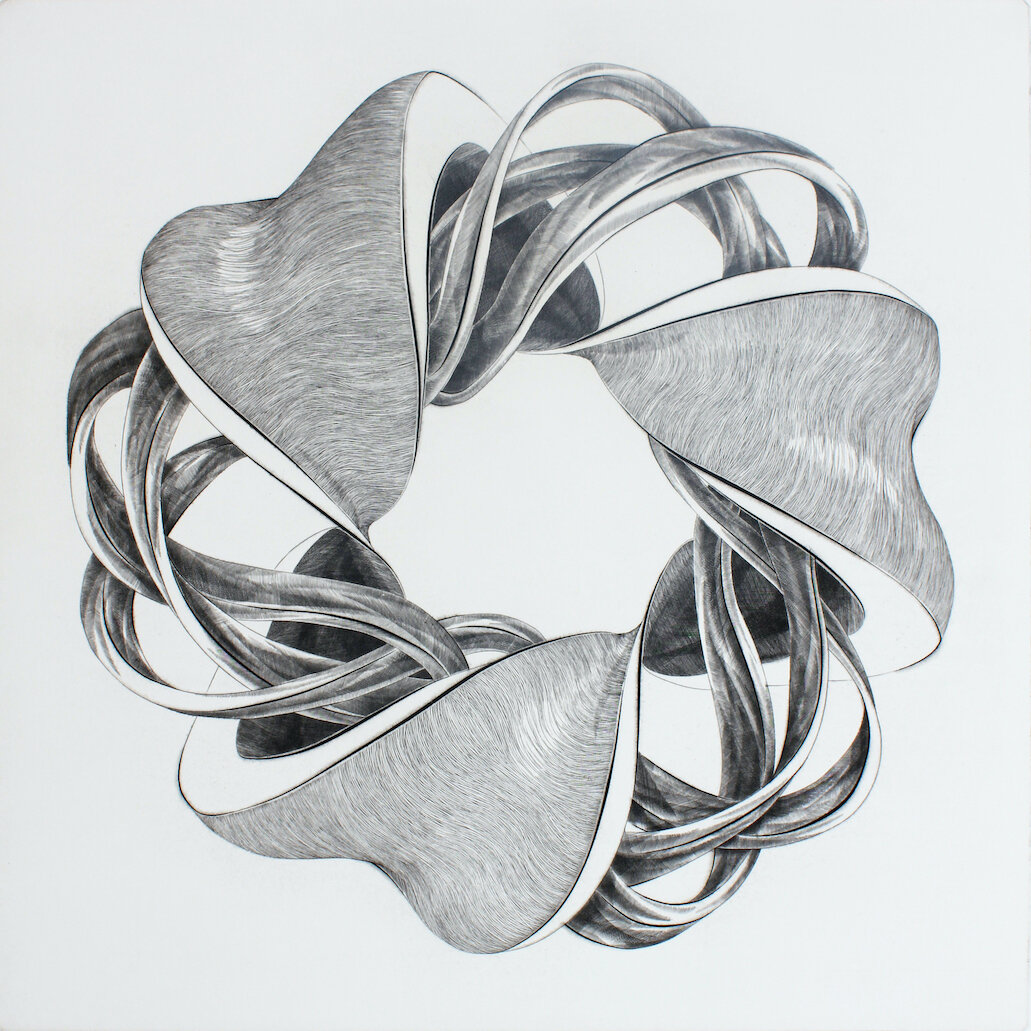
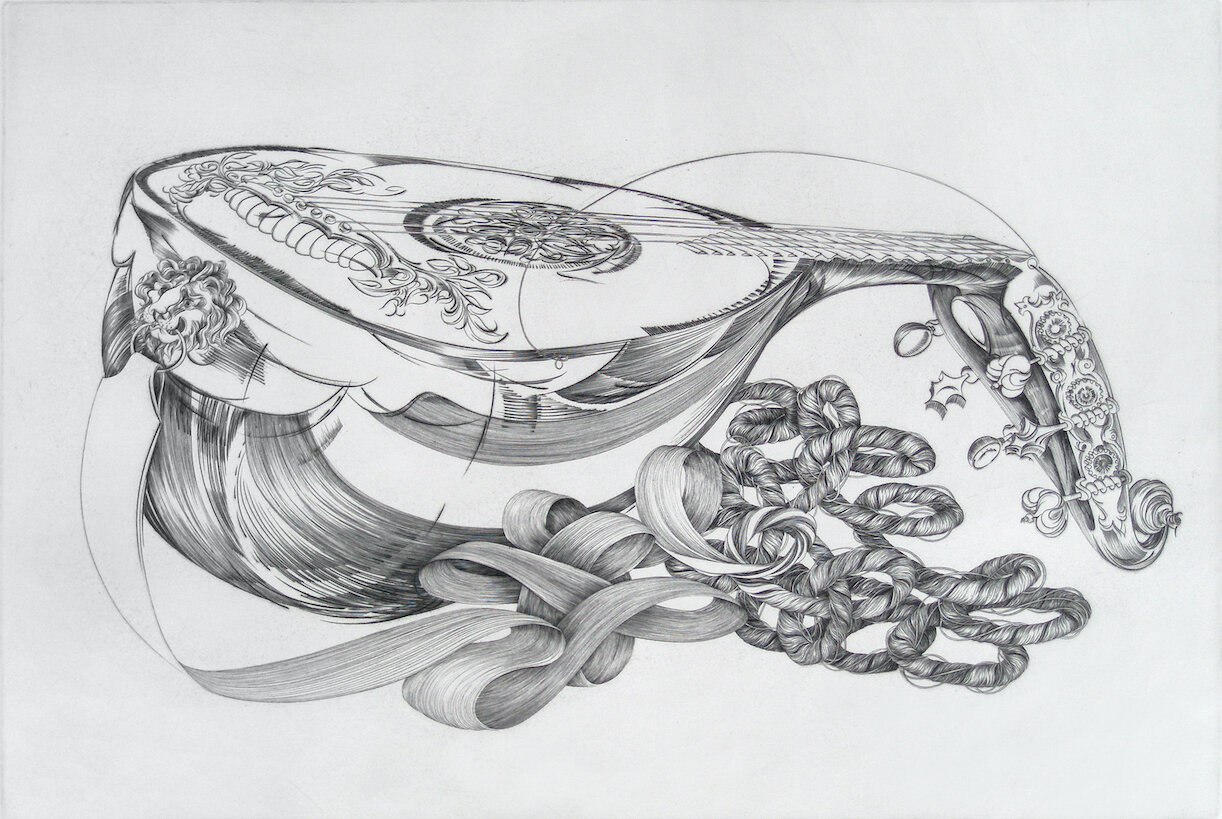

AAS: I read that you started your own calligraphy business as a teenager?
EL: In 1950 I was 14 years old. The president of national Alpha Kappa Lambda fraternity commissioned me to letter certificates and charters for AKL. That began a calligraphy business that was expanding. It kept me busy for ten years, and I gave it up when Sharon and I moved to Iowa City.
AAS: You have had many many honors but in 2013 you were named the Arkansas Artist Laureate. That must have been a great thrill. I’ve heard you say that you were surprised that a print maker would be selected for such an honor.
EL: Yes, that was a huge honor for me, and I was thrilled to accept it from a legislative act and Governor Mike Beebe.
By Heisstudying - Own work, CC BY-SA 4.0, https://commons.wikimedia.org/w/index.php?curid=54059460
AAS: How did you get started in engraving and becoming an engraver?
EL: My first attempt at burin engraving was 1957 as a student at Emporia State University. My teachers were Norman Eppink and J. Warren Brinkman. Both had worked successfully with the engraving process, but they had not explored it deeply. They encouraged me to apply to The University of Iowa to study with Mauricio Lasansky. When I got to Iowa City in July, 1960, I was told that being accepted into Graduate School did not guarantee that a person was automatically accepted to study with ‘Maestro’ Lasansky.
I purchased a copper plate and some tools at an art supply store, then sat at my work table trying many different things. When classes began in the Fall, I took my large copper plate to the first class and showed it to the Maestro. He ran his finger over the surface of the plate, puffed on his pipe, and called two graduate assistants over to him. He said, in his heavy Spanish accent: “Make thees boy a printer!” That was my invitation to study with him.
“I don’t begin working on prints without a deeper meaning than a first glance might reveal.”
AAS: Would you talk about the burin engraving process? Have you had to develop any of your own engraving tools or techniques to create the images you wanted?
EL: Burin engraving, also known as copperplate engraving, was the most important printing process during the time of Albrecht Dürer, but other processes were invented that were easier and faster. By the 1950s, little commercial use was being made of burin engraving, which seemed to be limited to engraving dollar bills and certificates. Teachers didn’t take the time to teach it, and during the twentieth century, it had become a forgotten art.
During the 1930s, Stanley William Hayter began spreading the knowledge and teaching of engraving. Maestro Lasansky had also worked at Hayter’s studio, Atelier 17.
Building upon my studies with Maestro Lasansky, I have developed my own techniques. It is a very simple, but difficult, process. Albrecht Dürer is often acknowledged as being the outstanding artist-engraver of all time. Dürer’s ideas and imagery were such formidable competition that most later engravers who came along after him simply chose the easy path of copying someone else’s work rather than be criticized for their own lackluster ideas. But there were many great engravers who have been mostly forgotten.
I’ve spent several years trying to call public attention to them, and at this point, I’ve created portraits of 25 or more in a series that I refer to as “Old Master Engravers.” For this series, I research the old master’s biography and work, finding points of interest.
The ideas are sketched out on paper with graphite pencil to the desired size. A copper plate is lightly coated with beeswax dissolved in mineral spirits and placed on the etching press. When the wax has dried, the sketch is placed over the beeswax. The press applies hundreds of pounds of pressure, causing the beeswax to lift a light layer of graphite from the paper sketch. The sketch is very fugitive, so I use an etching needle to lightly trace the lines onto the copper plate. These lines will be rough guidelines for the engraving. It’s really simple — not as complicated as it sounds. I clean the beeswax from the copper plate, and then the fun begins with the burin!
“I’m actually pleased when something accidentally occurs. True creativity is the act of solving problems.”
AAS: I have to ask, how do you deal with ‘slips’ or errors when engraving into the copper?
EL: Slips are accidental miscalculations concerning the positions of the burin and plate to each other. I’m happy to say that I don’t have major slips; however, small, inconsequential slips are to be expected. No problems!
Errors are something else. When I’m involved in the creative process, I push the limits beyond the bounds of certainty — that’s fun. Let’s face it — Being safe is just BORING! I often try something that probably won’t work. That’s my idea of CREATIVITY! And I’m actually pleased when something accidentally occurs. True creativity is the act of solving problems. If something doesn’t work, my job is to FIX IT UP! Somehow, I have to find a way!
AAS: How would you describe the perfect temperament for an engraver?
EL: If I were perfect, I could give a solid, undebatable answer. The best I can say is that each time I approach my workbench, I hear myself repeating my mantra: “This is what I was meant to do. This is what I do best. I will find myself in this plate.” When I am working, I’m in a state of total relaxation — perhaps it’s a trance. The trance-like state is broken temporarily as each exciting moment arrives for trying something different.
Spirit, engraving, Ed 100, 148mm x 105mm
AAS: I have always loved Spirit. There is something about the simple lines that capture its spirit. You have a series of similarly styled works in your Conversations series. I think you call it calligraphic lines. Would you talk about that style and maybe compare it to your other more complex portraits? Which do you find more satisfying to create – the more detailed ones with shading or the simpler more abstract ones?
EL: Spirit was an interesting plate since I wasn’t even thinking about doing a print. I was sharpening a brand-new burin — which can be frustrating. This burin was poorly made at the factory. The steel shaft was not perfectly square and the bend in the shaft was angled wrong. The wooden handle had been set to drag across the plate. Those problems are hard to fix. As I worked on the burin, I picked up a scrap of copper plate and made a few test cuts…. Then more grinding….Test again… etc. Eventually, I became aware that someone was smiling up at me. I filled in the image with more cuts, and it became a light-hearted spirit.
Those Conversations were fun. There are 15 of them in the complete series. They were entertaining to work on, because I was giving each one a personality, such as professor, goddess, poet, etc. I don’t begin working on prints without a deeper meaning than a first glance might reveal. As I designed them, I was thinking about the characters and what makes them different from each other. Their conversations could be long or short. Count the lines in the composition. It could be a ten-line conversation. Or a twenty-liner, etc.
Martin Schöngauer Engraves St. Anthony, engraving, Ed 35, 211mm x 267mm
AAS: One of my favorites from your Old Master Engravers series is Martin Schöngauer Engraves St. Anthony. There is always something new to see when I look at it. What did Schöngauer mean to you and how did you decide on the elements to include in that design?
EL: Schöngauer was extremely important, and his name and work should be much more familiar to people. He was an early printmaker, and he engraved a print of “Temptations of St. Anthony” that was copied by Michelangelo. Schöngauer was the finest German engraver before Albrecht Dürer, dying in 1491 — an easy year to remember. When I designed Martin Schöngauer Engraves St. Anthony, I was imagining what would happen if St. Anthony’s devilish tormentors were turned loose against Schöngauer. It was a great opportunity for me to be able to study Schöngauer’s burin techniques.
As I was designing the Schöngauer print ten years ago, I set up a camera and created a video. It may be seen in my YouTube channel.
You may notice that most of the Old Master Engravers were men. Historically, women were usually forbidden to sign their names to works of art. Recently, an artist in Italy wrote and suggested that I should engrave some women, and she suggested two names — Diana Scultori and Magdalena van de Passe. Both were important Old Masters. Diana Scultori Engraves for Vasari (see below) is my interpretation of the moment when the famous historian, Giorgio Vasari, visited Diana to write about her for inclusion in the second edition of his famous history of artists.
Another interesting artist that I studied was Claude Mellan who is most famous for his engraving known as “Sudarium of Saint Veronica.” It is a portrait of the face of Christ engraved with one spiraling line that begins at the tip of Christ’s nose. I wanted to try that technique, but I had no desire to copy Mellan’s portrait of Christ. I found that Mellan had earlier engraved a self-portrait, so I used Mellan’s spiraling line technique to engrave a portrait of Mellan (Claude Mellan Engraves a Self-Portrait, see below).
I’d like to mention one of the Modern Masters of engraving, Gabor Peterdi, who taught at Yale University. I met Gabor many years ago, and we traded engravings. One of his engravings is known as “Still Life, Germany.” It shows a hand and two feet of a cadaver. Gabor Peterdi was Hungarian. He was an artist who fled Europe and came to New York at the beginning of World War II. He joined the US Army and returned to Europe to fight against the Nazis, where he witnessed the horrors of the war. My engraving that features him is Gabor Peterdi Engraves a Still Life (see below). In it, I have engraved the foot of the cadaver to represent his “Still Life.”
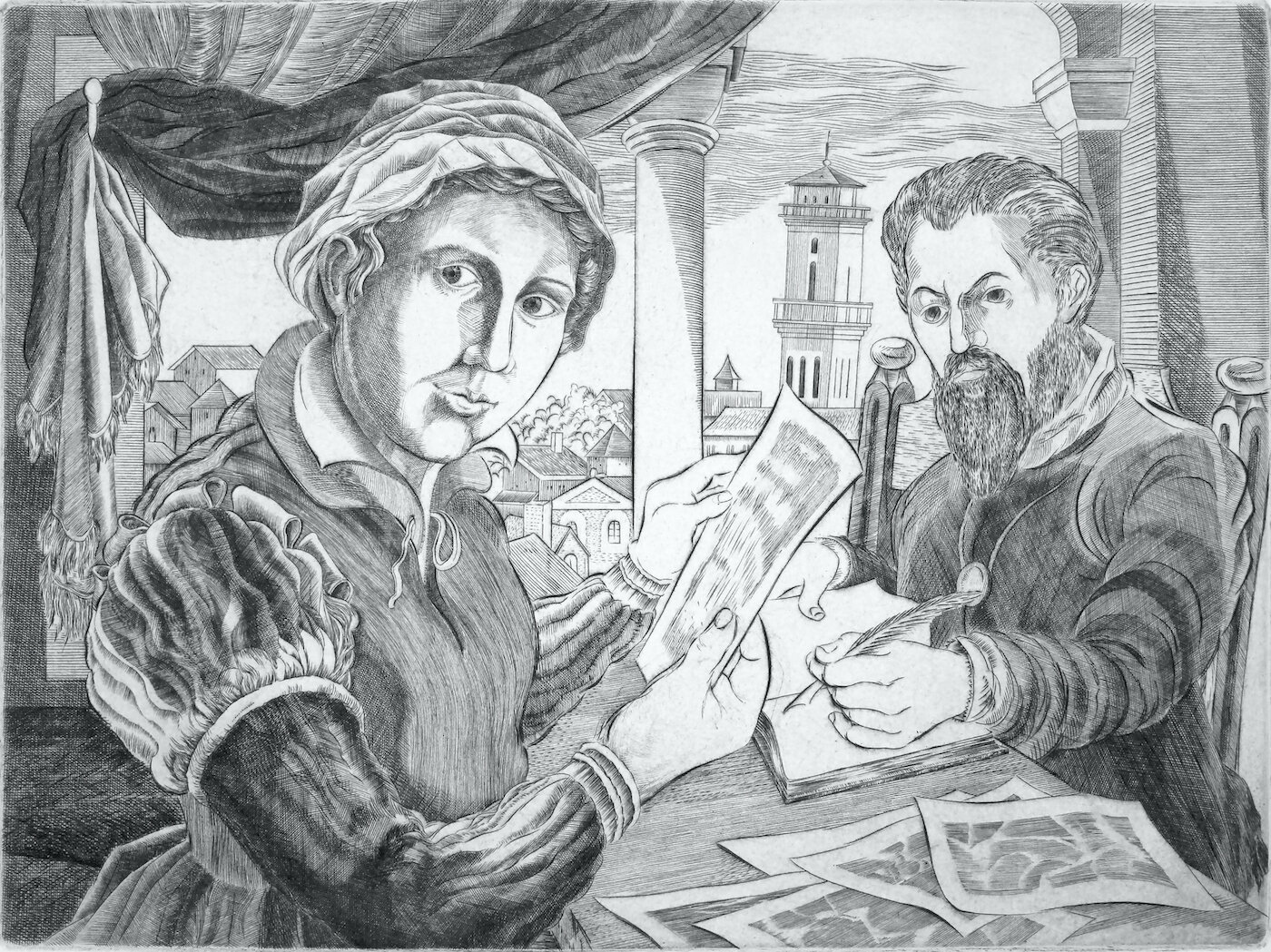
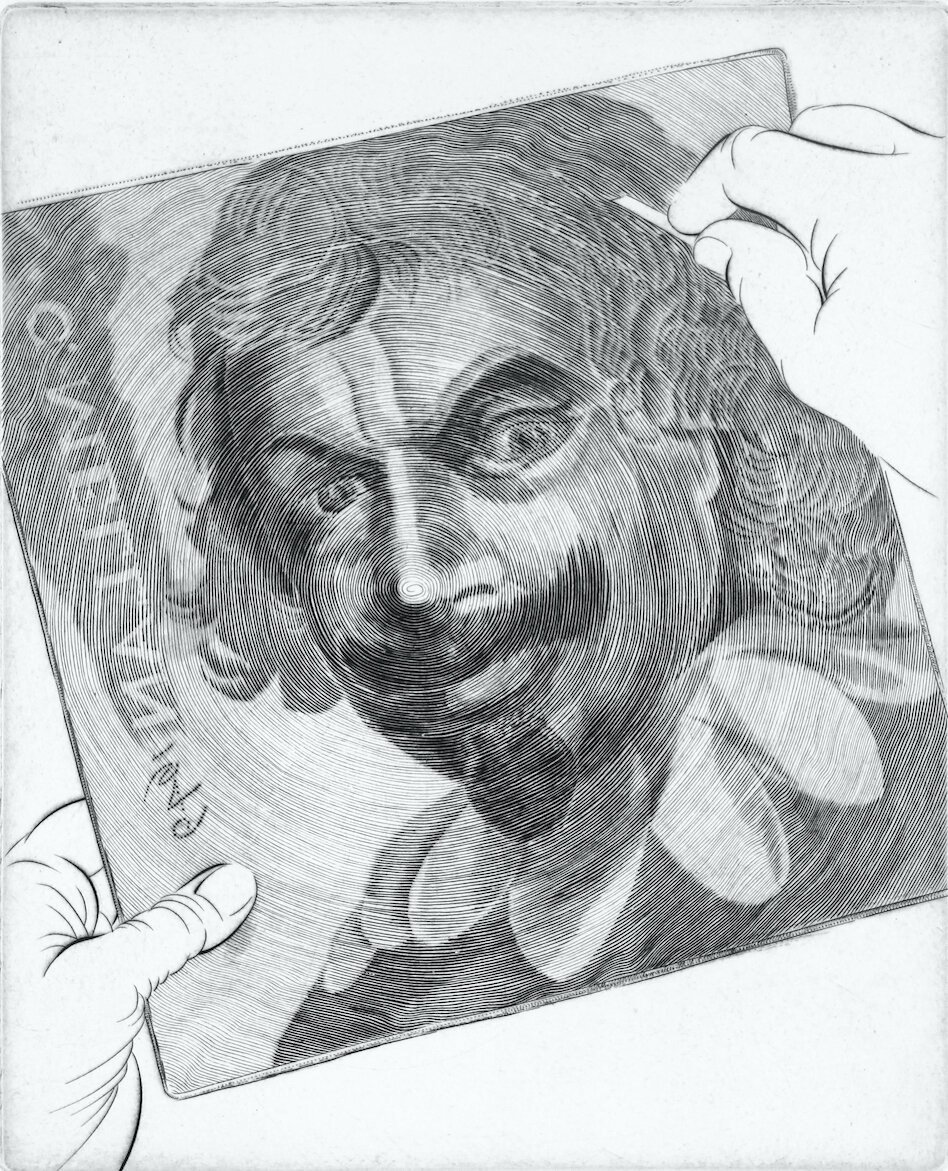
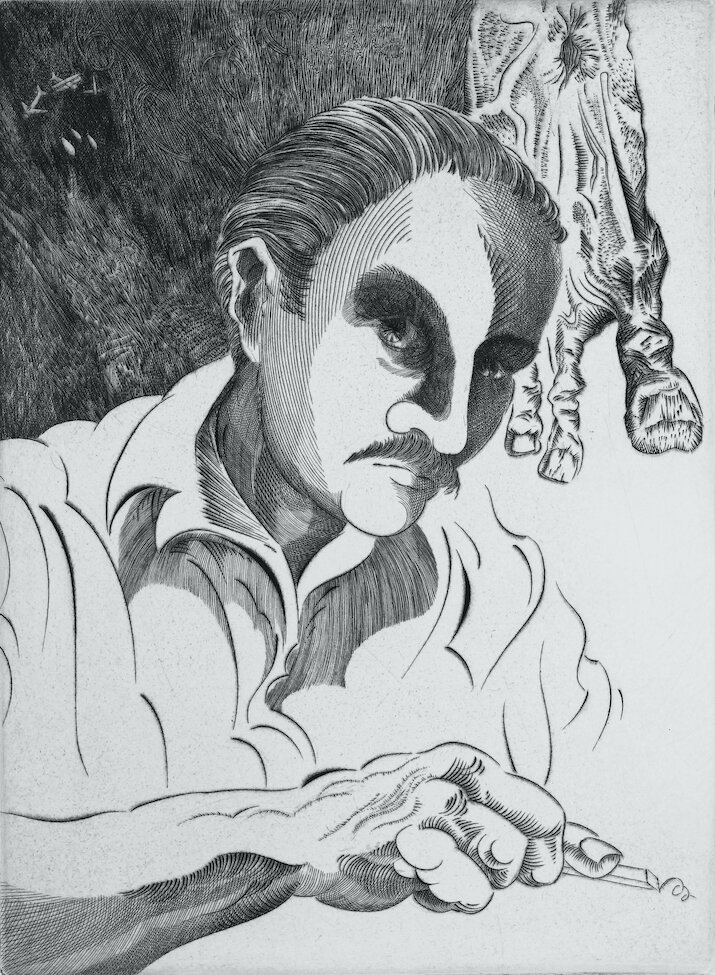
AAS: I find your String Theories series hypnotic, really. Would you talk about that series and was there a particular inspiration when you created the first piece?
Thought, engraving, Ed 100, 305mm x 305mm
EL: In 1965, some strangers dropped in to my studio. They were advocating the use of drugs to “expand the mind.” I argued that drugs probably closed the mind, but they didn’t understand my point. During the discussion, I picked up a book from the desk and opened it randomly to a page which had a black/white reproduction of a non-objective painting by Helen Frankenthaler. I asked what they could see in the image. They turned the book upside down and sideways. They were certain, that if they were to try this experiment in a chemically-altered state of mind they would be able to experience elevated sensory responses. One said it was my turn to study the reproduction. They expected me to admit that there was no response to be derived from it. They were calling my bluff.
But this image was rich when I turned it upside-down. I described things I was seeing in it. They did not make the connection. After they had gone, I began to sketch out in detail (with a sanguine conté crayon) some objects that leapt into view. It was becoming an interesting sketch. It led to a 1966 etching entitled Hallucination. In that etching, there was a tiny area of plant tendrils that interested me, and I began thinking about fibers. My wife was a weaver, and I saw fibers and strings on her loom every day. In 1968, I began experimenting with images of strings. I heard someone say — on the radio — that every string has two ends. I began to think that that was something that I should try to disprove.
I engraved Thought, a string twisting through space, picking up new twists and turns as it descends from above. It shows only one end, concealing the other, while retracing its path endlessly. Thought represents an idea that turns over in the mind endlessly without forming a conclusion. In some ways, Thought has become my Hallmark.
AAS: The designs are so complex and beautiful. They must be incredibly difficult to execute, but I bet a lot of fun to create too.
EL: They were difficult not only physically, but mentally as well. And yet, very enjoyable.
Guitar Maker, engraving, Ed 25, 518mm x 306mm
AAS: Has your notoriety as an artist open doors for you in Europe?
EL: In 1977, I went to Madrid, Spain, and witnessed the first FREE ELECTION in Spain in 41 years! The vicious dictator, Francisco Franco, had died. He had been a pal of Hitler’s. I was honored when the lady across the hall from where I was staying asked me to cast her ballot for her.
While I was in Madrid, I met the SubDirector of the Prado Museum, Javier Morales. He assisted me in making photographs in The Prado. He also arranged for me to study the entire collection of Goya drawings. Javier’s private secretary, Michelle Mayo, took me to meet the directors of Museo Reina Sofia and other museums. It was a great thrill!
On that trip I was also fortunate to meet M.G. Contreras, a world famous guitar builder! He actually asked me to design a new label for his classic guitars. He was so impressed with my design that he presented me with one of his beautiful guitars. I later created the engraving Guitar Maker in his honor.
My Thoughts, engraving, Ed 25, 254mm x 256mm
AAS: You have done a number of wonderful self-portraits. One of my favorites is My Thoughts because it in incorporates strings, birds and chess. Was that work intended to, in some way, summarize your work as an engraver?
EL: Yes, I was invited by the Birger Sandzen Memorial Art Gallery in Lindsborg to submit a self-portrait to an exhibition — a new take on the phenomenon of “selfies.” I wanted to show something about playing chess, partly because chess is important in the modern culture of Lindsborg. But I’ve often described the art of engraving as being like playing the game of chess. My Thoughts suggests that I’m playing chess against a Mockingbird who has won our match.
AAS: You are still creating extraordinary images after more than 60 years. What still excites you about the engraving process? Are you going to be stating any new series?
EL: Researching and engraving my prints is a routine that is well established after all these decades. I love it. I have a new work in progress that I expect will be finished in another month or two. It usually takes three months to engrave a plate and perhaps two or three weeks to print an edition. I don’t plan to start a new series, because I still have burning issues to fulfill with the Old Master Engravers.
AAS: You taught at Arkansas State University for some 40 years. Looking back over that time, what do you remember most fondly?
EL: There were many things that I enjoyed about my tenure as a professor. The best thing that happened in those 40 years was that Sharon and I proudly raised two sons who have been active in music and the teaching of art and art history.
In 1981, three people held a very successful fundraiser to build a studio for me. They were Ray Thornton, Wally DeRoeck, and John Troutt.
I enjoyed being able to stand before a crowd of 10,000 people and present President Bill Clinton with one of my engravings. I enjoyed the appointment by Ray Thornton, president of Arkansas State University, to be chairman of “The President’s Fellows,” a committee that he formed.
I was honored to receive Lifetime Achievement Awards from the Arkansas Arts Council and Society of American Graphic Artists (SAGA).
I was honored to receive the Distinguished Alumni Award from Emporia State University. Every day during those 40 years, I enjoyed the act (and the art) of teaching imaginative students and helping direct their artistic growth.
“When I’m involved in the creative process, I push the limits beyond the bounds of certainty — that’s fun.”
AAS: Where do you think the art of engraving is headed?
EL: The art of engraving has come a long way since the mid-twentieth century when it was so often described as a “lost” or “forgotten” art. The old “lost-art” idea was a reference to the fact that engraving was no longer used commercially, hence JOBS for engravers were rare.
S.W. Hayter changed that by teaching engraving as a medium for fine artists. He required artists working at his studio, including Picasso, to learn to engrave before working with other media. He promoted the styles of Surrealism and Abstract Expressionism, either of which could be done rapidly without the necessity of the artist being technically proficient with the burin.
When I was in High School and at Emporia State University in Emporia, Kansas, I was acquainted with Don Glaser, a family friend, who was inventing equipment for the printing industry. I left Emporia in 1960, and a few years later, I read that Don had become interested in engraving, and he had formed Glendo Corporation. Emporia State University became the world’s first four-year bachelor’s degree program in Engraving Arts.
Engraving has moved far from being a “forgotten” art. With Glendo and ESU actively promoting it, the art of engraving with modern power tools will continue to thrive. At the same time, the old art of copperplate engraving as practiced by Old Master printmakers will attract others to the burin process that was promoted by Hayter and other printmakers, such as Lasansky and Peterdi.
AAS: This is probably not a fair question, but which of your works has the most meaning to you?
EL: NO FAIR! I approach every print with a desire to learn from the unique process of creating it.


